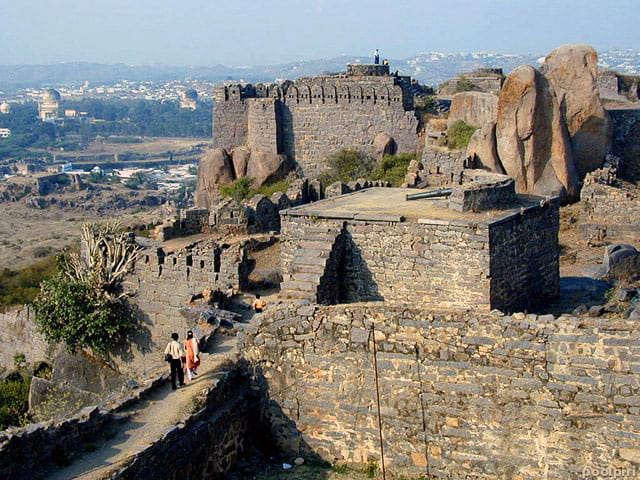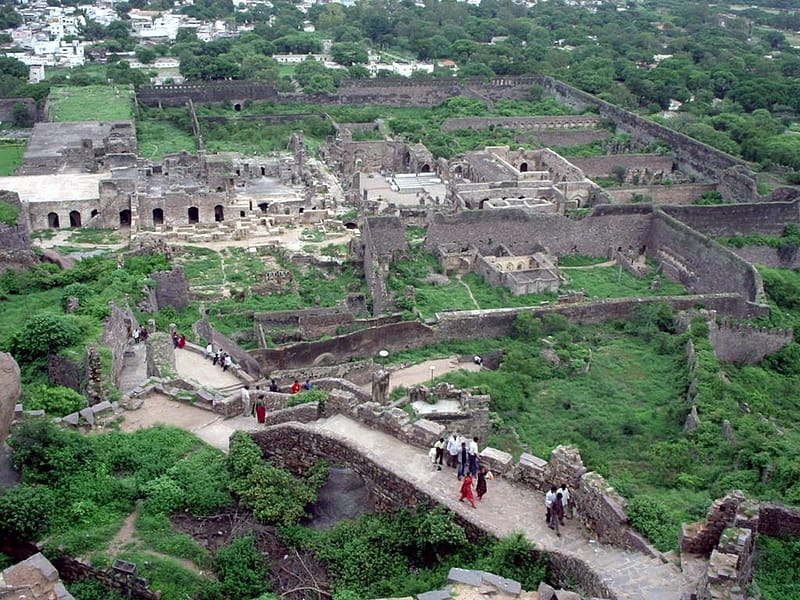Echoes of Past Splendour: India’s Golconda Fort
Margaret Deefholts takes you on a tour to the fascinating Golconda Fort near Hyderabad, India.
Story and Images Courtesy of our friend and fellow traveller Margaret Deefholts

Ali claps: one-two…pause…one-two. The sound reverberates hollowly against the massive walls and arched stone ceiling of the Fateh Darwaza, entrance gateway to the medieval fort of Golconda. A few seconds later, like a distant echo, we hear two return claps: one-two…pause… one-two.
Ali invites me to step up to him and say “hello”! “No need to shout,” he says, “just speak normally.” I oblige. The answering “hello” in a male voice, is deep and strong. “Let me try,” says one of the tourist onlookers. He mutters under his breath as he passes me, “…probably a hidden microphone somewhere around.” “What’s your name?” he whispers softly but clearly, “I’m Abdul Khan,” says the voice after a slight pause. “Look up at the Balahissar tower ramparts. I’m waving a flag for you.”
We step outside the Fateh Darwaza, shade our eyes against the strong sunlight and gaze at the crenellated bastion walls. Far above us, and about a mile away as the crow flies, a tiny stick-like figure emerges and flaps a piece of material vigorously in our direction.

Ali smiles wryly at his visitor’s skepticism. “No hidden microphones sir! Not today, not yesterday, not ever. This fort was built in the 1500s and its architects knew the secrets of acoustic wizardry.” He points out a series of fluted diamond shaped indentations along the ceiling and the upper walls. “Those patterns direct the sound of your voice out towards that building…” he indicates a long narrow stone wall running at right angles to the gateway structure, “…and by some means, still unknown to us, the echo bounces off the structure and carries up to the Balahissar lookout post.” He adds, “No cell phones back then, so this was an early warning system. If the guards up on the ramparts spied any suspicious movement in the surrounding area, they would inform the guards on duty here, who would immediately swing these gates shut.”
Ali walks over to the massive doors, studded with enormous steel spikes to prevent elephants from ramming them open. “The Golconda fort was unassailable,” he says. “It had its own wells, a sophisticated system of water distribution pipes, and the inhabitants farmed their own produce and reared livestock within these walls, so the city could withstand siege indefinitely.”

But Golgonda wasn’t all that invincible. Its three concentric stone walls, formidable as they were, offered no defense against human treachery and greed. The last great Mogul Emperor, Aurangzeb, after a nine-month long siege, invaded the fort when a saboteur was bribed to open the Fateh (Victory) Darwaza.
My guide Ali is arrow-straight, and his ebony skin and tight curly hair proclaims his ancestry; he is a descendant of one of the Ethiopian guards, employed at Golconda by the Qutb Shahi rulers who founded Golconda in the 16th and 17th centuries. We walk along a pathway flanked by an ammunition depot, and a series of mortuary baths where royal corpses were ceremonially bathed before burial. He leads me up the uneven stone stairs, past a couple of small mosques and a Hindu temple, and as we climb up to one of the lookout posts, the surrounding countryside comes into view. The ten-kilometer outer wall caterpillars its way around the perimeter, and is studded with eighty-seven semi-circular bastions, and this one where I now stand, has its original iron canon still in place. I sweep my binoculars across the landscape: gigantic boulders of black granite, some of them weathered into bizarre shapes, spill across straggling scrub and thorn. Eleven kilometers away, a cluster of buildings shimmer in the heat haze—it is the bustling city of Hyderabad, capital of the Deccan province of Andhra Pradesh in peninsula India.

We move on to the elaborately carved Balahissar Darwaza (doorway) and I steel myself to tackle a further 380 steps to the crest of the fort. Ali slows his pace down, and hauls me up some of the more massive stone steps, unsuited to my short legs and creaky knees. The sun seems to gain malevolence as we ascend, and by the time we reach the top, rivulets of perspiration trickle down my neck and back, and despite a large brimmed hat, my skin feels hot and flushed. All worth it. The Balahissar Baradari (grand pavilion), and the view from its terraces is stunning.
The pavilion itself is triple-storied and decorated with a series of arches. A warm breeze fans through the open-sided structure, and it carries with it the smell of dust and the scent of some nameless little yellow wildflowers that have sprung up in the rocky terrain. The Darbar or ceremonial hall was where the rulers held public or private audiences, and the very topmost terrace with its royal throne, served as a pleasure pavilion. Standing at this lofty height, it is easy to imagine a sultan seated here surrounded by his courtiers, sipping wine from his diamond studded goblet, and applauding performances by nautch girls with their tinkling silver anklets, their flashing eyes, and provocative glances.

Ali points out twin buildings, perched on a rocky outcrop and toy-like in the distance. Two sisters, Taramathi and Premamathi, lived in these little palaces, and legend has it that when they sang from their pavilions, their voices, pure and clear floated right across the vast undulating rock strewn landscape, to charm the royal entourage on Golconda’s Balahissar terrace. Apparently, the buildings had been cleverly positioned so that the sisters’ music was carried on night winds to their enraptured audience.
We clamber down the narrow, steep steps, to the entrance of Rani Mahal (queen’s palace)—a zenana, or enclave occupied by the women of the court and guarded by eunuchs. The complex has high ceilings and enormous rooms, their walls covered with stucco designs, alcoves and niches. In its heyday these rooms and passages would have echoed to the sound of feminine laughter, and children’s gleeful shouts as they chased each other around the pillars. The baths would have been scented with exotic oils and perfumes, and the sunlight streaming through the windows would have glinted on gem-studded gold ornaments, which graced the necks, wrists and ankles of the royal ladies.
Golconda is reputed to have been the source of the fabled Kohinoor and Hope diamonds, but whether that is true or not, this rugged fort and nearby Hyderabad was known for its enormous wealth—and even today, the city is reputed for satiny pearls, worked into exquisitely designed necklaces, earrings and bracelets by craftsmen whose skills have endured through the centuries.
It is late afternoon by the time Ali brings me back to the Fateh Darwaza at the entrance to the fort. I perform a farewell hand-clap, to applaud Golconda’s splendors, and sure enough, as I peer up at the Balahissar, a distant figure comes out onto the terrace, and his acknowledging echo wafts back to me.

Story and Photos by Margaret Deefholts
Last updated February 22, 2021 by Matthew George – Webmaster
IF YOU GO:
The Sound and Light Show
The history of Golconda comes to life in a vivid interplay of audio and visual effects. The shows are presented in English, Hindi and Telugu.
Show Timings:
Winter: (November – February) 6:30pm,
Summer (March – October) 7:00pm
Duration: 55 minutes
In English: Wednesday, Sunday
In Hindi: Tuesday, Friday, and Saturday
In Telugu: Thursday
Closed on: Mondays
Getting There:
Air: Hyderabad can be reached by air, from all the major cities of the country.
Rail: Hyderabad is well connected by rail to all parts of the country.
Road: There is a regular bus service to Hyderabad from many cities in southern, central and southeastern parts of the country.
City Transport: Golconda Fort is about 11km from Hyderabad. Auto rickshaws and Taxis are available apart from luxury/semi-luxury buses, for local transportation
Photo of Golconda Fort overlooking Hydrabad, India: courtesy of Arusha Gopalratnam
